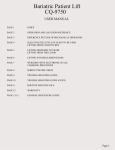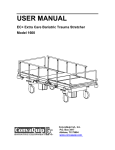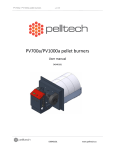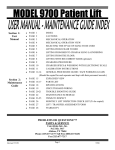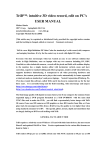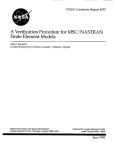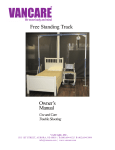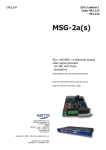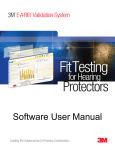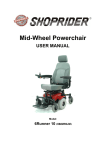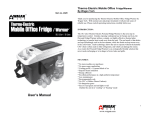Download USER MANUAL - ConvaQuip Industries, Inc
Transcript
FOR CUSTOMER ASSISTANCE P.O. Box 3417 Abilene, TX 79604 Toll 800-637-8436 [email protected] www.convaquip.com As a future reference, we suggest you record the information listed below for quick accessibility. Model No.: _________________ Serial No.: _________________ Purchase Date: _____________ Purchased From: __________________________ ConvaQuip Ind, Inc Service: Toll 800-637-8436 USER MANUAL For Bariatric Patient Lift MODEL 9750-1000 Read this user manual carefully before using Patient Lift Limited Warranty Registration Card Enclosed PAGE 1 INDEX PAGE 2 CAUTIONS PAGE 3 MECANICAL OPERATION PAGE 4 MECHANICAL OPERATION VIEW PAGE 5 SELECTING THE STYLE OF SLING TO BE USED LIFTING FROM CHAIR TO BED PAGE 6 LIFTING FROM BED TO CHAIR LAUNDRY INSTRUCTIONS PAGE 7 LIFTING FROM THE FLOOR PAGE 8 LIFTING WITH RECUMBENT BARS (optional) PAGE 9 WEIGHING WITH ELECTRONIC SCALE / CHARGING PAGE 10 SCALE CALIBRATION PAGE 11 SPECIFICATIONS PAGE 12 EXPLODED VIEW PAGE 13 PARTS LIST PAGE 14-15 TROUBLE SHOOTING GUIDE PAGE 16 MAINTENANCE SCHEDULE PAGE 17-19 ITEMS TO INSPECT PAGE 20 MONTHLY LIFT INSPECTION CHECK LIST (To be copied) PAGE 21 LIFT / TRANSFER ASSESSMENT PROGRAM PAGE 22-24 GENERAL PATIENT PROCEDURE GUIDE (To be copied) PAGE 24 SAFE WORKING LOAD PAGE 25 WARRANTY PROBLEMS OR QUESTIONS??? PARTS & SERVICE POINT ConvaQuip Ind., Inc. P.O. Box 3417 Abilene, TX 79604 Phone (325) 677-4177 ~ (800) 637-8436 Customer Service Fax (325) 677-7217 Revision 7-16-08 Page 1 9750-1500 PLEASE READ BEFORE OPERATING 1. CONVAQUIP LIFTS ARE DESIGNED FOR TRANSFERRING ONLY, NOT FOR TRANSPORTING OVER LONG DISTANCES. 2. FOR THE SAFEST TRANSFER, CONVAQUIP LIFT LEGS MUST BE FULLY EXTENDED INTO THE WIDE POSITION WHEN LIFTING A PATIENT OR RESIDENT. 3. FOR EMERGENCY STOP, PULL BATTERY FROM BATTERY RECEPTACLE. 4. MAKE SURE ALL FOUR LOOPS FROM THE SLING ARE PROPERLY “NESTED” IN THE BOTTOM OF THE HOOKS BEFORE LIFTING OR TRANSFERRING A PATIENT OR RESIDENT AND THAT ALL FOUR RETAINER SPRINGS ARE FUNCTIONING. 5. USE ONLY CONVAQUIP SUPPLIED SLINGS AND ACCESSORIES DESIGNED FOR USE WITH THE CONVAQUIP LIFT MODELS. 1. DO NOT PUSH OR PULL ON THE BEAM OR RESIDENT. THIS WILL JEOPARDIZE THE LIFT’S STABILITY. 2. DO NOT USE ANY OTHER BATTERY CHARGER.USE ONLY THE BATTERY CHARGER SUPPLIED WITH THE LIFT. 3. DO NOT EXCEED THE WEIGHT LIMIT LISTED ON THE LIFT 4. DO NOT PLACE FINGERS BETWEEN THE SAFETY GUARDS OF THE BEAM TRACK. 5. DO NOT ATTEMPT A TRANSFER FROM THE FLOOR BEFORE EXAMINING FOR ANY INJURIES THAT MAY NEED SPECIAL ATTENTION. 6. DO NOT USE A SLING THAT SHOWS WEAR, IS TORN, BLEACHED OUT, OR HAS ANY LOOSE THREADS. INSPECT BEFORE EVERY LIFT. Page 2 1. This lift is powered by a 24VDC removable battery pack located at the back of the lift. The battery fits all four directions in the lift and charger receptacle to make it easy to remove and insert the battery. 2. The lift has a built-in battery indicator which illuminates when the battery is about 60% used up. This would be the best time to replace with the battery that is full in the charger. 3. Once the battery is inserted into the charging receptacle, the charge light on the charging unit comes on. Make sure this yellow light comes on to assure your battery is charging. Once the battery is fully charged, the light will turn green. The charger is fully automatic and will quit charging when the battery reaches a full charge. You will not damage the battery or charger if left plugged in all the time. 4. The lift is operated by switches located at the tips of the handles. This allows proper ergonomics by keeping the hands on the handles while operating the lift and maneuvering it at the same time. 5. The optional hand control provides a second source to operate the lift. This allows the operator to be next to the person being transferred and operate the lift at the same time. It also aids as a back-up source to operate the lift. 6. If for any reason the lift would stop in mid-travel, the first thing to check is the circuit breaker located on the battery receptacle. If the breaker has popped out, simply press it back in and try lifting. If the problem is not the breaker, and you cannot lower the patient/resident by the switch on the handle or the remote control, you must use the manual safety override speed wrench provided with the lift. 7. To operate the lift manually, insert the manual override speed wrench. Insert the speed wrench through the access hole at the back of the lift indicated by the sticker stating “Manual Override”. Turn the wrench in the direction of the arrow on the sticker to lower the lift manually. Depending on the distance needed to travel, this could take several minutes to lower. A faster option would be to use a 1/4” socket driver and an electric drill inserted in the same location as the manual override speed wrench supplied. 8. The leg adjuster opens and closes the legs of the lift. By pushing forward on the handle, you can maneuver the handle around the stopper plate until the handle snaps into the fully extended leg position. This function enables the lift to be narrowed to go through doorways and widened to go around a wheelchair or lounge chair. 9. The brakes are located on the rear wheels. Press the tab with your foot to lock the wheel and the pivot. Press the upper portion of the tab forward to release the brakes. Page 3 Page 4 SELECTING THE STYLE AND SIZE OF SLING TO BE USED The first step is to select the Style of sling to be used. The most common sling is the divided leg sling. The person must have two full legs in order for you to use the divided leg sling. (Not meant for amputees) This sling is designed to be removed from the person after they have been transferred into their wheelchair so the patient does not have to sit on the sling throughout the time they are sitting in their chair. If you find it difficult to remove a divided leg sling from behind a person while they are seated in a wheelchair, you may choose to leave it behind them. However, be sure to observe the correct position of the sling before you lift that person. The sling may have moved. If a person has leg discomfort while you use the divided leg sling on them, we would recommend the hammock sling. If you are lifting a single or bilateral amputee, you must always use a hammock sling. The hammock sling comes with or without the commode hole and with or without head support. Note: The hammock mesh sling can only be made up to a size 3X and ConvaQuip does not recommend the divided leg sling above a size 2X. The second step is to determine the proper Size. It’s simple. Lay a sling across the persons chest. If it’s the proper size sling, you will note 2-8 inches of extra material extended past the side of each arm. NOTE: This is only a guide. Body shapes vary so much that fitting the patient to the sling ultimately needs to be determined by the health care professional. If you observe little or no fabric extended past the arms, you must upgrade to a larger sling. All styles have a color coded border to easily indicate the size of sling. (Refer to your sling sizing chart available on the website at www.CONVAQUIP.com) The loops on the straps are color coded to match each side in positioning the sling to the desired location. Changing the orientation of these loops will change the angle of the person being transferred. This comes in handy for charting the colors that would work best for each individual. All sling styles come with built in positioning handles on the back of the sling. These always face out and are used to position a person back in a chair. LIFTING FROM CHAIR TO BED (NOTE: ALWAYS INSPECT THE SLING BEFORE EVERY LIFT—READ CAUTION SHEET) To apply the divided leg sling on someone sitting in a wheelchair, first lean the person slightly forward to get clearance between the back of the person and the back of the wheelchair. Keeping the sling from twisting, work the sling along the crevice between the legs and the chair. Make sure the sling is all the way down and that there is no gap behind the person. If the sling is not all the way down, it will not come under the leg easily. Work the sling alongside the legs, getting as much material going toward the front of the chair as possible. Raise the leg and pull the material through, trying to prevent any wrinkles. Crisscross the inside flaps with the main loops, then thread the strap with the color-coded loops through the main loop down to the stopper, and do the same thing on the other side. Crisscrossing the inside flaps will keep the legs tight together for a more comfortable and dignified transfer. If during the transfer it is required for the person’s legs to relax open, you can hook it up without crisscrossing the inside flaps. This will allow the legs to relax open. Now that the sling is positioned, bring the lift toward the person, open the legs of the lift to the wide position, lower the hanger until the desired colored loops can be hooked on the hanger. It doesn't matter if the front or back is hooked up first. (NOTE: RAISE UNTIL THERE IS TENSION ON THE STRAPS, THEN DOUBLE CHECK TO MAKE SURE SLING LOOPS ARE NESTED INTO THE BOTTOM OF THE HOOKS PROPERLY.) Now push the up button on the handle or use the remote control to raise the person high enough to clear the bed. Position the lift so that the person will be lowered to the proper position in the bed. Once there is plenty of slack in the straps, remove the loops from the hanger and pull the lift out of the way. Unthread the straps from the main loops. Roll the person on their side and fold the sling, then roll to the other side and remove the sling. Page 5 LIFTING FROM BED TO CHAIR When transferring from bed to chair just reverse the previous steps. Roll the person to their side and fold the sling. Align the bottom of the back of the sling by the tailbone. Roll the person to their side and pull the rest of the sling through, straightening any wrinkles. Bring material under the legs the same way as if they were in the chair. Crisscross the inside flaps and thread the straps through the main loops. Bring the lift in, spread the legs, and lower hanger near the center of the person being transferred. It is recommended to keep the legs in the widest position at all times when transferring a person who is uncooperative or combative. Bend the knees and hook up the color coded loops that were previously used to bring them to a sitting position. Press the button to raise the lift and make sure the material under the leg stays straight toward the knee, keeping out as many wrinkles as possible. Note: Raise until there is tension on the straps and then double-check to make sure the loops are nested in the bottom to the hooks. If the base is in the narrow position, adjust it to the widest position once you are clear from the bed and always before turning the lift. Once the patient is over the chair, lower and guide them by the built-in handles on the sling to bring them back far into the chair. (Do not attempt to move the lift by pushing on the person or the beam.) To remove the sling, reverse the step. Unthread the straps from the main loops, raise the legs, and pull the material aside. Now lean the person forward and pull sling clear. CONVAQUIP SLING LAUNDERING INSTRUCTIONS 9750-1000 (FULL BODY LIFTS) The sling material and webbing are made of nylon. If possible, put the sling in a mesh bag to prevent the straps from getting tangled. Recommended washing instructions are as follows: Machine wash warm - gentle cycle Tumble dry - LOW HEAT ONLY - or drip dry Non-chlorine chemical disinfectants OK NO BLEACH WARNING: EXCESSIVE HEAT AND/OR BLEACH WILL SHORTEN THE SERVICABLE LIFE OF THE SLING. IF THE SLING IS DAMAGED DUE TO IMPROPER LAUNDERING, WARRANTY IS VOID. Page 6 LIFTING FROM THE FLOOR To transfer from the floor, apply the sling with the same procedure as if they were in bed. If the person is on the floor as a result of a fall, no transfer should be attempted until it is determined that there are no injuries. Once the sling is positioned under the person as if they were lying in a bed, bring the lift up to the person being transferred from either the head or legs. If the lift is brought in by the head, apply a pillow (or PC45002-1-0 Head Protector (E) available from CONVAQUIP) between the head and the base of the lift. (The reverse may be done as well with the patient’s legs resting on pillows on the base of the lift.) Lower the lift to the lowest position and hook up the front two straps to the hanger. You will need to use the two extension straps supplied with the sling ( A ). This strap loops through itself ( B ) in order to extend the head end of the sling strap low enough for a floor lift. A second set of straps can be used to extend it further if necessary. ( C ). Figure ( D ) shows a divided leg sling with the extension straps attached to the head end of the sling. Push the lift as close to the patient as possible, then lock the brakes. (When bringing the lift in by the legs, lift the legs onto the base, cushioning with pillows.) Now hook up the back two straps by bending the knees and applying the loops to the hanger. All the models of slings come with straps on the foot end that are long enough to transfer from the floor. Note that we are using the sling with a built-in head support. If you are using a sling without head support, you will need to support the patient’s head with your hands. B A E D C Page 7 RECUMBENT BAR INSTRUCTIONS (optional) The R-bars were developed in response to several requests from customers to develop a system that will transport hip patients. The system will also lift patients whose bodies are rigid. Previous to the R-bar system, nurses had no choice but to lift their patients manually, thereby placing themselves and patients at risk. Caution: Be sure to consult with the patient’s health care provider for proper patient positioning and transport. The R-bar system is designed to be used on CONVAQUIP LIFTS only! Instructions: 1. Assess the Patient: Consult with the patient’s nurse. 2. Prepare the CONVAQUIP LIFT: Remove the R-bars from the bag. Attach the Rbars to the J-hooks on the CONVAQUIP LIFT. Double check the connections. Observe the black nylon loops. If frayed, cease activity and order new loops. Be sure to hang the R-bars directly under each moving hanger bar from the lift. You want the Rbars to mirror image the movement of the existing hanger bars. Do not attach the R-bars perpendicular to the hanger bars. 3. Safety: Observe the R-bar sling you will be using. Check the fabric for tears, holes and frays. If damaged, replace with a new sling. 4. Place the Abductor Pillow: Place the pillow between the groin and the knees. Note a white label that says “CONVAQUIP”. You should be able to read that label as it is placed properly between the legs. 5. Place the Sling: Rest the sling beside the patient. Log roll the patient to one side. Carefully slide the sling underneath the patient. Be sure the bottom of the sling will rest at knee level. Roll the patient back and pull the remaining material out until you see that the patient will be directly in the middle of the sling. 6. Lift the Patient: Open the legs of the CONVAQUIP LIFT. Place the R-Bars directly over the patient. Use the patient’s navel as a centering point. Lower the lift enough to provide ease of sling hook-up. Double check your connections. Adjust the head support. Tell the patient you are about to lift them, then lift. Lift the patient high enough to clear the bed and transport to the nearest recliner. Center the patient over the recliner and lower the patient. DO NOT MANIPULATE THE LIFT BY PULLING ON THE PATIENT! Remove the abductor pillow and leave the sling underneath the patient. Before you lift the patient from the recliner to transport back to bed, check to see that the sling is in the correct lifting position. If not, reposition the sling. Open the legs on the CONVAQUIP LIFT. Apply the abductor pillow. Lift, Transport and Lower the patient into bed. Unhook the sling and move the lift aside. Remove the sling from under the patient. Observe the sling for contaminants. If soiled, launder per CONVAQUIP sling instructions. Page 8 WEIGHING WITH ELECTRONIC SCALE (optional) The electronic digital scale allows the person to be weighed during a transfer. Press the “ON/ZERO” button to turn on the scale. Make sure that “LOW BAT” did not appear on the screen, if so replace the four “AA” batteries located on the side of the scale. The scale will take about 5 seconds to zero itself. Place the desired sling onto the hanger, making sure it is not touching the ground, and press the “ON/ZERO” button. This will place the weight of the sling into memory and will automatically deduct the weight of the sling from the reading. This reading will always stay in memory even if the scale is shut off until you run this procedure again. Now with the scale still on, remove the sling and place it beneath the person being weighed. Select pounds or kilograms by pressing and holding the units button to toggle back and forth. Lift the person clear of the chair or bed. Once the reading is steady, the scale will lock on the reading to make it easier to read if the person will not remain steady. The scale runs on four AA batteries. The scale has a built-in battery indicator that will warn you when the batteries are getting low. The scale will automatically shut off by itself if left untouched over 2 minutes. To manually shut off the scale, simply press and hold the “OFF” button until the screen goes blank. The optional Litter Attachment or Recumbent Bars can be used to weigh someone who is bedridden and must be lifted in a horizontal position. The scale will zero out the weight of the litter or recumbent bars to resemble the most accurate weight. CHARGING PROCEDURE 1. The lift has a battery indicator light located on the receptacle that will flash when the battery is low. This is the best time to exchange the battery with one that is fully charged at the charger. 2. Keep the charging receptacle on a counter or flat surface near an outlet where where it will not get damaged. 3. With the charger plugged into the outlet, the battery can be inserted either way into the charging receptacle. Insert the battery from the top, making sure the yellow light comes on to indicate contact. If it is red, leave the battery on the charger overnight to see if it will revive. This may take as long as 48 hours for a fully discharged battery. 4. When the green light on the charger has lit, the battery is fully charged and will shut off automatically. It will not overcharge the battery. The charger will not be damaged if left in the wall at all times The charger will get warm during its charge cycle NOTE: If lift is not used daily, batteries must be removed from lift to prevent battery damage. Page 9 P.O. Box 3417 Abilene, TX 79604 Toll Free: 1.800.637-8436 www.convaquip.com HANGING AND DUAL DISPLAY SCALE CALIBRATION INSTRUCTIONS PC350/PC450/HD450/9750-1500/VL110 1. Should calibration be necessary, all that is required is a 25 lb. precision weight. Do not use packaged goods, fitness weights, or other items that say they weigh 25 lbs. Failure to use a precision weight may cause the scale to display an inaccurate weight. Using a certified weight is the method preferred. When calibrating scale, remove hand control from the lift and have the beam positioned in the middle of its stroke. 2. To enter calibration mode, push “ON/ZERO” button. 3. While holding the “ON/ZERO” button, press and hold the “LB/KG” button. After approximately 3 seconds the message on the display will change from “ZERO” to “CAL”. Release both and the display will show “C O”. 4. Hang strap or sling that will hold calibration weight on the hanger hooks. If using a sling, make sure it is empty. Push the “ON/ZERO” button. The display will count down from “16” to “0”. When finished the display will show the message “C 25”. 5. Now hang 25 LB. calibration weight on strap which you previously attached to the hanger (step 4, above) or place it in the sling and permit the scale to stabilize. (Failure to stabilize the unit may cause the scale to display an inaccurate weight – see below.) 6. Push “ON/ZERO” button again. Scale will count down from “16” to “0” as before and then the display should read “25”, which is the weight of the calibration weight. Calibration is now complete. 7. Remove the 25 lb. precision weight, stabilize the sling or strap, and press the “ON/ZERO” button to zero the scale. The scale is ready to use. Notes on how to stabilize the unit: Weight must be centered directly below the beam Do not side load the scale Permit the weight to stop bouncing or swinging NOTE: Switching between lbs. and kg. may trigger a need to recalibrate. Call CONVAQUIP Customer Service if you have any questions. Page 10 Page 11 Page 12 Page 13 CONVAQUIP LIFT Model 9750-1000 TROUBLESHOOTING and MAINTENANCE GUIDE ONTINUED) PROBLEM CAUSE SOLUTION LIFT 1. Lift won’t go up. 1. 2. 3. 4. 5. Bad lift control switch Dead battery Hand control is broken Actuator not working Battery is not making connection 6. Circuit Breaker popped 1. Remove and replace 2. Switch batteries 3. Send in hand control for repair or order new parts 4. Replace motor 5. Make sure battery pack is making contact with terminals in the receiver box; replace terminal contacts 6. Push in circuit breaker 1. Not enough grease on actuator 2. Loud ticking noise when lift goes up and down 3. Faulty or worn out actuator 1. Put #2 grease on the full length of the actuator screw 2. Replace actuator nut 3. Replace actuator 1. Batteries are worn out or circuit board is bad 2. Batteries are not being charged when the RED charge battery light comes on 1. Order new batteries or order new circuit board 2. Leave battery on for 48 hours; order new batteries; also make sure that you charge the batteries when the RED light comes on at the lift. 1. Fuse is blown in the Transformer 2. Electrical outlet may not be operational 1. Order a new transformer 1. Charger bad – verify by using new battery 2. Battery dead 1. Battery shorted or reversed leads 2. Charger needs to be reset 3. Battery is totally discharged 1. Order new charger 2. Order new battery ACTUATOR 1. Actuator makes noise BATTERY PACK 1. Charge battery light stays on constantly 2. Batteries wearing out too quickly BATTERY CHARGER 1. Battery charger lights do not come on when plugged in 2. Yellow light does not come on when battery is inserted 3. Red light stays on Page 14 2. Use different outlet 1. Check terminal contact springs for wear and replace 2. Take out battery, unplug transformer, but battery back in, plug in 3. Leave battery on charger for 48 hours to see if it will revive. CONVAQUIP LIFT Model 9750-1000 TROUBLESHOOTING and MAINTENANCE GUIDE PROBLEM CAUSE SOLUTION SCALE 1. Inaccurate weights 1. Not zeroing out scale properly 2. “Lb” to “Kg” switch is in the wrong setting 3. Batteries in scale are low 4. Person in lift is moving excessively while taking weight 5. Scale is out of calibration 1. Zero scale according to instructions 2. Switch to desired setting 3. Replace the four “AA” batteries in scale 4. Make sure the patient is hanging evenly under the hanger and there is minimal movement 5. Calibrate the scale following the calibration instructions 2. Display is erratic 1. “AA” batteries in scale low. 2. Scale is out of calibration 1. Replace four “AA” batteries 2. Calibrate scale 3. Display is blank 1. Power to scale is not turned on 2. 4 AA batteries are bad 3. Scale is damaged 1. Turn scale on 2. Replace batteries 3. Call tech. support for instructions Page 15 MAINTENANCE SCHEDULE CONVAQUIP Model 9750-1000 Every Day Every 3 Months After each person you lift, you should check the sling, and wash if needed. Refer to the CONVAQUIP laundering instructions Check the condition of all slings. If you are in doubt of its operational ability to safely lift a person, then discard the sling and order a new sling Check to see that strap retainer flapper and spring are working. Check the lift; if the “RED” light is on , then charge the batteries Keep your CONVAQUIP lift clean by wiping it down with a damp cloth. Use a mild detergent if needed NOTE: Do not use a petroleum based solvent on paint, stickers, or plastic. Periodic Testing General Lift CondiLube pivot points on lift tion: A general visual Grease actuator with a good inspection of the exterheavy duty #2 grease. nal parts and all func(Note: DO NOT USE A tions can be carried out SILICONE OR WD 40 at any time to ensure TYPE LUBRICANT ON no adverse damage has THE ACTUATOR) occurred. If any Check leg adjuster stop for doubt, withdraw the signs of wear equipment from use Check the movement of the and call the CONVAlift; remove hair from the QUIP Service Departcasters if needed ment. Check leg covers; if cracked replace with new Other Maintenance Check all vinyl covers; if worn, replace with new Hanger bolt must be Check all external fittings; replaced every three tighten where needed years. NOTE: At the back of this manual you will find a sample Actuator bearing (ball screw nut) must monthly inspection sheet and be replaced when check off list. We encourage grinding wear is you to make copies for each heard but not longer lift and keep for your records. than 5 years. (800) 637-8436 THIS IS A SUGGESTED MAINTENANCE SCHEDULE DEPENDING ON USE. THE EQUIPMENT MAY NEED TO BE INSPECTED MORE FREQUENTLY. Page 16 CONVAQUIP IND., INC. - LIFT ITEMS TO INSPECT P.O. Box 3417 Abilene, TX 79604 Toll 800-637-8436 1-3-07 1. HANGER: FULL BODY LIFT STRAP RETAINER SPRINGS ATTACHING HARDWARE BEARINGS ARM PIVOT PADDING HANGER BOLT REPLACED EVERY THREE YEARS 2. Y-BEAM: STAND LIFT STRAP RETAINER SPRINGS PADDING 3. BOLTS AND NUTS TORQUE BOLTS UNDER BEAM PADDING TO 55 POUNDS CHECK ALL BOLTS AND NUTS 4. LEG ADJ. HANDLE CONDITION (Check wear at pivot points.) ATTACHING HARDWARE SPRING 5. LEG ADJ. NOTCH PLATE WEAR (Are legs kept securely in locked position?) ATTACHING HARDWARE 6. LEG ADJ. STOP PIN/ ROD WEAR 7. LEG LINKAGE HARDWARE CONDITION 8. SLINGS (Reasons to discard) WORN FRAYED BLEACHED OUT 9. ACTUATOR: NOISE-UP/DOWN (Replace bearing after 5 years.) WITH AND W/O WEIGHT GREASE (should be greased at least semi-annually) 10. SCALE: ACCURACY (Calibration needed?) BATTERIES MOUNT Page 17 11. POWER BOX: PLASTIC GUIDES TERMINALS (Bent or worn) 12. LED: REMOTE JACK HOLDER OR LENS 13. THUMB SWITCHES LEFT AND RIGHT 14. REMOTE SWITCHES STRAIN RELIEF CORD (Replace if stretched out or cut.) 15. CASTERS BRAKES SWIVEL ROLL BEARINGS 16. LEG BUMPERS CRACKED OR MISSING 17. KNEE REST: (STAND LIFT) SAFETY STRAP PADDING PIVOT ADJUSTING PINS/KNOBS 18. CHARGER OPERATION LIGHTS TERMINALS (Bent or worn) 19. BATTERIES LOAD TEST AGE 20. GRIPS 21. LEGS PIVOT ATTACHING HARDWARE ALIGNMENT Page 18 22. WELDS VISUALLY INSPECT FOR CRACKS 23. PAINT 24. BEAM SAFETY SWITCH LIFT UP ON BEAM WHILE HOLDING DOWN BUTTON 25. DECALS CORRECT MISSING 26. OTHER: Page 19 Page 20 CONVAQUIP LIFT PROGRAM LIFT / TRANSFER ASSESSMENT FORM CAN INDIVIDUAL SAFELY PERFORM > OR = 50% OF LIFT / TRANSFER WITH ONLY STANDBY ASSISTANCE FROM CAREGIVER? NO YES CAN INDIVIDUAL BEAR WEIGHT ON AT LEAST ONE LEG? YES NO LIFT NEEDED NO DOES THE INDIVIDUAL HAVE MODERATE UPPER BODY STRENGTH AND ABILITY TO FOLLOW SIMPLE COMMANDS? YES THAN THE MAXIMUM CAPACITY OF THE CONVAQUIP FULL BODY LIFT? NO NO DOES THE INDIVIDUAL WEIGH LESS THAN THE CAPACITY OF THE CONVAQUIP SIT-TO-STAND LIFT SIT-TO-STAND REQUIRED DOES THE INDIVIDUAL WEIGH LESS CONTACT SAFETY COMMITTEE YES FULL BODY LIFT REQUIRED CONTACT SAFETY COMMITTEE Patient Name _________________________ ID#_________________Room#_____ Assessment Completed by____________________________Date_____________ Lift(s) Required___________________________Sling Size___________________ Comments for PRN Use_______________________________________________ Assessment Updated by_____________________________ Date_____________ _____________________________Date_____________ _____________________________Date_____________ Assessment Care Planned by_________________________Date_____________ Page 21 This form is intended as a guide to help you develop a procedure sheet that will fit your specific application in your facility. It is recommended that everyone be inserviced by the company representative or use the manufacturer’s inservice video before operating any mechanical lift. Staff Name: Date: Checked Off By: General Preparation: Yes No 1. Identify the resident or patient or patient. 2. Explain what you are going to do 3. Wash hands. 4. Get supplies ready, sling, wheelchair, blanket or lap robe. 5. Get help from experienced team member for this procedure. 6. Have assistant stand on opposite side of bed to assist with transfer. 7. Provide privacy. Pull curtain all around the bed. General Procedure: Yes No 1. Position wheelchair at foot of bed. 2. Adjust bed to working level. 3. Make sure battery indicator does not indicate a low battery. (If so replace) 4. a.) Examine lift sling for any damage: tears, frays, or weak areas. b.) Make sure the correct size sling is to be applied. c.) If weighing resident or patient, hang the sling on the hanger hooks, press the on button. Page 22 Yes No 5. Lower side rails. 6. Roll resident or patient to one side and place sling, folded halfway under resident or patient. Top of sling should be approximately at shoulder blade area. Bottom of sling should be approximately near the tail bone. 7. Roll resident or patient to other side and pull rolled half of sling through. Smooth sling and check correct placement. 8. Roll resident or patient onto center of sling. Pull padded legs on sling along each side and wrap inside thigh areas close to groin area. Crisscross straps through the holes before hooking to the lift. 9. Raise head of bed slightly 10. Position lift over bed and instruct assistant to help guide lift into proper position. 11. Check that base legs of lift are in wide position where applicable. If base position must remain in a narrow position, make sure the lift area between bed and chair are clear of any obstacles. Widen once clear from bed. 12. Attach straps on sling to lift. Remember that the straps at the thigh area must be crisscrossed at the hanger before lifting. 13. Tell assistant to guide resident as you begin to lift them from the bed using “up” button on hand control or up button at handle grips. Once there is slight tension on the straps check to make sure all four loops are still on the hooks before lifting. 14. Lift resident or patient until buttocks have cleared the bed. Give reassurance to allay fears. If weighing, steady resident or patient and look at the reading on the scale. 15. Tell assistant to steady the resident or patient in lift and guide to position over wheelchair, trolley, tub lift, etc. CAUTION: Push and turn the lift from the handles only. Pushing on the top of the beam or on the resident or patient could jeopardize the lift’s stability. 16. Lock wheelchair brakes. 17. Instruct assistant to stand behind wheelchair and place hands in positioning straps on both sides of sling while the resident or patient is coming down pull the handles back to position the resident or patient in an upright position. 18. Disconnect all straps from the hanger and remove sling by raising legs and pulling along sides. Ask resident or patient to lean forward to remove for back and hip area. Page 23 Yes No 19. Move lift away and adjust for comfort. Apply safety belt if ordered. Position feet on foot pedals. 20. Cover lap with blanket and leave call light within reach. 21. Wash hands. Report reaction and overall tolerance to team leader. SAFE WORKING LOADS CONVAQUIP slings have been developed, tested and manufactured to have a safe working load of 1500 lbs. Due to the variety of resident shapes and dimensions, the appropriate size should be selected to accommodate specific patients. Care should be taken to ensure that the mechanical lift selected has the capacity to safely lift the resident. The CONVAQUIP Sling Sizing Chart is designed only to suggest which resident will safely fit into the sling based on their size and weight. (Sling sizing chart is available on the CONVAQUIP website www.convaquip.com ) NOTE: Lifts are designed to “transfer” a resident, not “transport” them. Page 24 1 YEAR *LIMITED WARRANTY ON ALL PARTS ONLY UNDER CONDITIONS OF NORMAL AND INTENDED USE. *10 YEAR WARRANTY ON THE MAIN STRUCTURE OF THE LIFT. MISUSE, DAMAGE OR ALTERATION OF BODY LIFT OR ANY OF ITS PARTS, VOIDS THE WARRANTY. NO OTHER WARRANTIES WRITTEN, VERBAL, IMPLIED OR OTHER THAN LISTED HERE WILL BE HONORED. *SHIPPING CHARGES NOT INCLUDED. ConvaQuip Ind., Inc.. P.O. Box 3417 Abilene, TX 79604 PHONE: (325) 677-4177 ~ (800) 637-8436 FAX 325-677-7217 www.convaquip.com Page 25


























